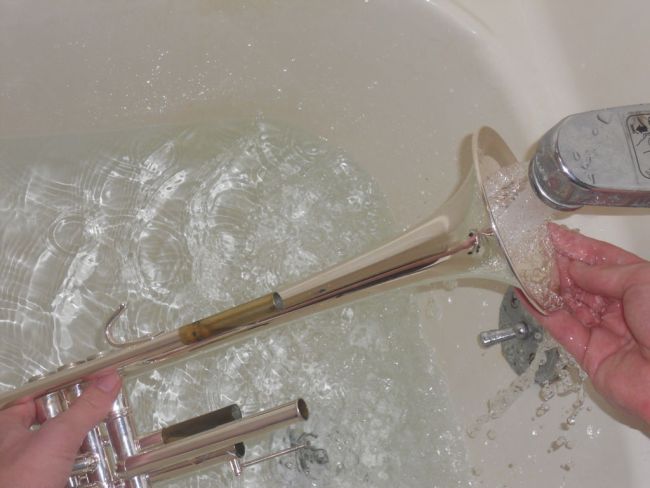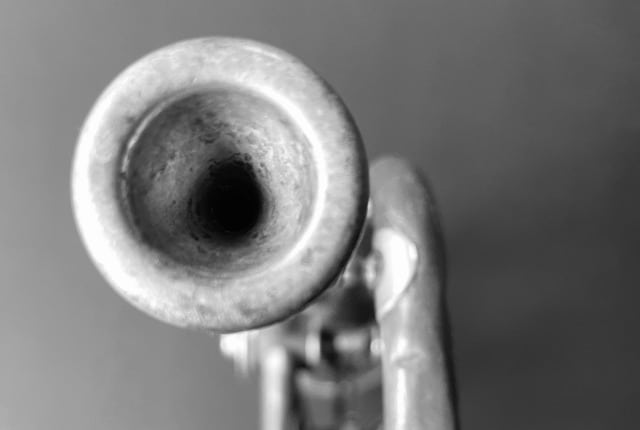This is a helpful guide for those who don’t know how to clean a trumpet the correct way. We want to save you, the trumpet player, from wasted time or potential damage.
Every trumpet player should be prepared to maintain their instrument to get the best performance and results when playing. Maintaining a trumpet requires regular oiling as well as cleaning, so players should know how to clean the instruments properly. After all, nobody likes a sticky valve!
The process is easy to do, but it may take a while to accomplish with the first few tries if you don’t know how to clean a silver trumpet. Over time it will become a much quicker process (15 to 20 minutes) with practice. Cleaning your trumpet is very easy as it basically requires simple washing of the trumpet’s components.
Supplies Needed For Cleaning A Trumpet
Only a few tools are needed to keep trumpets clean, and some of these can be omitted or substituted when necessary:
Small Cleaning Snake/Pipe Cleaner

You’ll need a small cleaning snake or a pipe cleaner* to clean the insides of the slides. A cleaning snake should be part of any trumpet cleaning equipment.
A cleaning snake won’t break the bank and usually last you a long time – they’re usually also included in any available trumpet cleaning kit.
Valve Casing Brush

A straight brush on a sturdy wire, the valve casing brush* will help you clean out the valve casings.
If you’re doing a thorough clean, use this after immersing your trumpet in water. You’ll be surprised at how much gunk you’ll get out of your trumpet with one of these.
Mouthpiece Brush

The mouthpiece brush* is how you clean the trumpet mouthpiece. It’s similar to the valve casing brush but the bristles are arranged in a cone shape.
You can use this regularly on just your mouthpiece to make sure it’s always nice and hygienic – you’re pressing your mouth to it after all.
Dish soap
Any regular mild dish soap will do to bathe your trumpet in for cleaning.
Valve Oil

You’ll use valve oil* to oil your valves before you put your cleaned trumpet back together again.
Any valve oil will do, from Music Nomad to Al Cass. Some oils have a particular scent that doesn’t appeal to everyone, so you might want to try various valve oils to find the one you like best.
Slide Grease

Slide grease* is used for greasing your tuning slide and valve slides. Again, don’t overthink which brand to use, just try a few and see which you like best.
Polishing cloth
Use the polishing cloth* to make your trumpet really shine.
Sink, Small Tub or Other Container
Should be big enough to immerse your trumpet completely. You can also use your bathtub for this, although a smaller container will save a lot of water.
Note
You can actually purchase complete kits online that contain all of the trumpet cleaning supplies you would need to clean your instrument. Yamaha makes a trumpet cleaning kit that is highly recommended.
Trumpet Cleaning Steps
Step 1: Take the Trumpet Apart
- Remove the valves.
- Place them somewhere safe where they cannot be knocked by kids or pets.
- Be careful when moving them so as not to drop them, and make sure not to separate the valves.
- Remove the slides by starting with the first.
- Continue with the second slide.
- Move on to the third slide and remove it.
- You will eventually also remove the main tuning slide.
It only requires small force to remove the valves and slides, so don’t apply too much force to do so. If you come across a stuck valve, do not force it out. If you cannot remove the part, seek the help of a trumpet professional to continue disassembling the instrument.
Looking for a teacher?
Want to get lessons at the comfort of your own home? Check out the course Learn to Play the Trumpet: Beginner to Pro Made the Easy Way* on Udemy! (See their full trumpet course line-up here*!)
Step 2: Cleaning the Tubing and Slides
- Fill the sink/container with enough warm water to completely immerse the trumpet.
- Mix a few drops of the dish soap with the water.
- Place the trumpet’s slides in the soapy water and allow them to soak for a few minutes
- Use the cleaning snake to clean the insides of the slides.
- Rinse and dry them before placing them on a thick towel.
- Immerse the entire trumpet into the water, and let it soak slightly.
- Gently run the snake through all of the tubing without forcing it into tight areas.
- Run the valve casing brush through the valve casings several times.
Rinse the trumpet before allowing it to dry.

Step 3: Clean the Valves
Do NOT completely immerse the valves in water as the felt pads can will get wet and lose their shock-absorbing ability. If these parts do get wet or compressed you will have to change them.
- Use the cleaning snake to clean the ports of the valves.
- Rinse them with soap and water.
- Make sure to avoid making contact with the metal point of the cleaning snake as it can damage the insides of the valve ports.
Step 4: Reassemble the Trumpet
- Oil the valves, first slide and third slide before putting the trumpet back together.
- Grease the main tuning slide and second valve slide, and make sure to NOT grease the third valve slide as it will become too slow.
Extra Tips
- Use warm water only, as water that is too hot can damage the trumpet’s finish.
- Do not remove the water keys or any triggers using a spring as a special tool is needed to put them back on. If can be extremely difficult to get them back in place without the right equipment.
- Use silver polish* to remove grime or tarnish from silver-plated trumpets.
- Never use polish for a brass or silver trumpet on one with a lacquer finish as the polish may remove the finish.
And that’s it! Congratulations, your trumpet is now clean and shiny! Don’t be too discouraged if the whole process took you a while – it will get a lot easier with time and practice.
How to clean a tarnished silver trumpet
Usually, you’d clean a silver trumpet with a silver polishing cloth* along with some silver polish*. They are cheap and usually get the job done quite well. Lather the instrument up and then wait a few minutes before you polish it all off again.
However, sometimes dark spots remain. This is due to a chemical reaction where the silver fuses with sulfur atoms, so your polishing alone might not help. The trick here is to use some baking soda and aluminum foil to transfer the sulfur atoms to the aluminum instead. This is how you do it:
You need:
- several gallons of hot water
- 3 cups of baking soda (simple Arm and Hammer will do)
- aluminum foil
- Boil some water
- Fill the container you usually use to clean your instrument in with enough hot water to soak your instrument in.
- Add baking soda
- Put at least two or three cups of baking soda in the water.
- Stir and let cool
- Stir the mixture so the baking soda dissolves. Once it’s dissolved, you can wait for the water to cool down a bit before you put your horn into it. Lukewarm water is fine, just to be sure you don’t damage your instrument.
- Wrap instrument in aluminum foil
- Next, wrap your trumpet loosely in aluminum foil and place it in your container. Rotate it a few times and wait.
- Dry and polish
- Next, dry your horn thoroughly and polish with a polishing cloth.
It should now look a lot better!
How often should a trumpet be cleaned?
Depending on how much you play, you may want to clean the lead pipe and tuning slide once a week, then give your trumpet a full wash inside and out at least every six months.
How much does it cost to have a trumpet cleaned?
If you want to get your trumpet chemically cleaned, expect pay between $50 for a simple flush and $145 to also get an ultrasonic cleaning. The ultrasonic cleaning will remove dirt without harming the metal and is therefore safer than using harsh chemicals.
If you’re looking for a service that will do this for you, look locally or consider the people over at flipoakes.com.
Can you boil a trumpet mouthpiece?
Yes, you can boil your mouthpiece for a few minutes to sterilize it. This is particularly helpful if you’ve bought it used and want to make sure it’s extra clean before playing it.
Boiling will likely not help you get rid of any visible spots or discolorations, though. To take care of those, see the procedure mentioned above. (If your gold mouthpiece has black spots, it is likely the layer of silver below it tarnished.)
TrumpetHub.com is a participant of the Amazon Services LLC Associates Program, an affiliate advertising program. Links marked with an asterisk (*) are affiliate links. If you buy a product through an affiliate link, we will get a small commission without extra cost to you. This helps us earn an income off the free content we provide to you. Thank you for your support!






